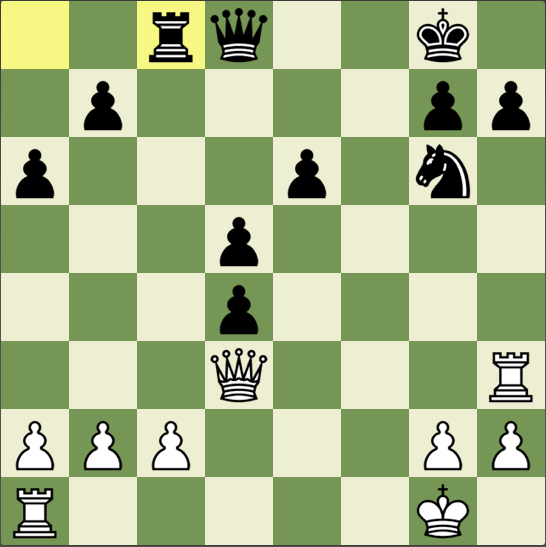I’m back! The past couple months were pretty busy for me with school, an interesting machine learning project, and of course chess. After all, summer is the main chess season for Americans. Time to get back to where I left off!
This year, I spent my Easter weekend at the Foxwoods Resort and Casino, playing in the Foxwoods Open. 5 rounds, 4 foreigners, and 3 GMs into the tournament, I had 4/5 and a 2600+ FIDE performance. Everything was simply going great!
Then in round 6, I faced a setback by losing to GM Hovhannes Gabuzyan (2620 FIDE, 2711 USCF) with black. Out of a non-theoretical but equal opening, I spiraled downward. I honestly can’t explain most of my moves in the early middlegame. I recovered somewhat, but the position was very bad for me throughout the entire game, and I cracked in the end.
Time for revenge after that awful game!
In round 7, I got white against Eugene Yanayt (2276 FIDE, 2363 USCF). I got a comfortable advantage out of the opening, but then some hiccups crept into my play…

While this doesn’t appear to be anything special on the surface, this position is very nice for white. His pieces are more active, and black doesn’t seem to have a real plan besides holding tight. My plan was to open up the kingside with f5-f6, and I decided to strike before he could play Kf6 with 24.f5 Ne5 25.f6+ gxf6 26.Be4

White is temporarily a pawn down, but that won’t last long. The f6-pawn will fall one way or another. Black’s knight looks nice on e5, but it really isn’t doing much. And again, what is black going to do here? He really doesn’t have a clear plan. My opponent played 26… R8c7 which I met with 27.Rg1+ Ng6 28.h4. If 28… h5, black’s kingside is softened up considerably. I can consider 29. Rfg2 to win a pawn and infiltrate black’s position, ideas with Ne6+, or just waiting and strengthening my bind. My opponent played 28… f5 and after 29.Nxf5+ Bxf5 I made a big mistake

After 30.Rxf5, white is much better. Material is equal, but white is so much more active and will likely infiltrate black’s position. Also, black’s chances for counterplay are minimal. Instead, I played 30.Bxf5? which ran into 30… Rxd5! 31.h5 Rcc5!

I had missed 31… Rcc5! and realized that things weren’t easy here. White is still better, but there was no point giving black all this counterplay. 32.hxg6 Rxf5 33.gxh7+ Kxh7 34.Rh2+ is not mate because of 34… Rh5. 32.Bg4, with the idea of a discovered check if black simply moves the knight, looked promising. 32… Rxh5 33.Bxh5 Rxh5 didn’t worry me, since white can attack the d6-pawn with 34.Rd1 or 34.Rd2. Black will be lucky not to lose the pawn, and his kingside pawns will be too slow. However, 32… Rg5! annoyed me. After 33.hxg6 f5 34.gxh7 fxg4, I wasn’t confident I’d win the rook endgame.
I chose another option: 32.Rgf1 Ne5 33.h6+ Kxh6 (33… Kg8 34.Be6!! was a neat tactic I had in mind) 34.Rh1+ Kg7 35.Rxh7+ Kg8

So far, so good, but here I had a blackout. White can win his pawn back by playing 36.Rg2+ Kf8 37.Be4, after which he has an advantage. Somehow I didn’t see this and played 36.Rh6? which blows all my advantage. I saw that I had nothing in the rook endgame after 36… Nc4+ 37.bxc4 Rxf5 38.Rxf5 Rxf5 39.Rxd6. I was lucky that my opponent let me repeat once with 36… Kg7? 37.Rh7+ Kg8. This time I saw it and played 38.Rg2+ Kf8 39.Be4 Rd4 40.Bxb7

Material is equal, but white is better. His pawn structure is intact, his king is safer, and his bishop is better than black’s knight. Black can’t simply run his passed f-pawn down the board because that would weaken the 7th rank and his king. My opponent made a few mistakes under pressure, and I won without much difficulty.
Phew! That was a wild ride. In round 8, I got black against IM Dean Ippolito (2339 FIDE, 2427 USCF). For norm purposes, I needed to win this game. I really wanted to win this game, but I wasn’t going all-in either. I was totally willing to take reasonable risks, but committing suicide wasn’t my plan!
The opening was fairly dry, and I turned down a draw offer on move 14. Maybe I would’ve taken it in a different situation, but I just wanted to play.

On the surface, this position doesn’t look very exciting. White has more space and central control, but with so many pieces exchanged, black is totally comfortable. Now he’s got to figure out what to do. The b6-pawn is hanging, so black has to decide what to do with it. 21… Rb8 is probably ok, but it looks fairly passive. 21… Bxc4 22.Rxc4 is also fine for black, but I didn’t see how I’d have any realistic winning chances there. What else is there…? 21… c5 22.Nxb6 Rb8 is a nice idea, but it simply loses to 23.dxc5. 21… Na2 22.Rc2 Nb4 23.Rcc1 is a move repetition, but I don’t want a draw.
Then I saw it. After repeating moves once with 21… Na2 22.Rc2 Nb4 23.Rcc1 Na2 24.Rc2 I struck with 24… c5!?

YOLO! I didn’t calculate everything to the end, but I thought this was a good winning attempt that wasn’t very risky. After 25.Nxb6 Rb8, white can’t play 26.dxc5 because of 26… Rxd1+. That’s why I included Na2 and Rc2 before playing c5. If 26.Nc4, black will be m uch better after 26… Nb4 27.Rcc1 Rxd4 28.Rxd4 cxd4. Yes, white can play 29.Nxa5, but after 29… Bxe2 black’s d-pawn is simply a monster.
uch better after 26… Nb4 27.Rcc1 Rxd4 28.Rxd4 cxd4. Yes, white can play 29.Nxa5, but after 29… Bxe2 black’s d-pawn is simply a monster.
My opponent found the best move 26.Na8, and after 26… cxd4 27.Nc7 Rbc8 28.Nxe6 Rxc2 29.Nxd8 I had to decide how to proceed.
Black is still a pawn down here, but he can win it right back by taking on e2 or b2. However, that will most likely not be enough for an advantage. For example, 29… Bxe2 30.Rxd4 Rxb2 looks fine for white, since he has plenty of activity and isn’t in danger of losing the a4-pawn (without taking on a5 himself that is). 29… Rxb2 runs into 30.Bd5+ Kf8 31.Ne6+ Ke7 32.Bxa2 Rxa2 33.Nxd4 Rxa4 with equality. Instead, I chose the best option 29… Nc1!. The game continued 30.Bd5+ Kf8 31.Ne6+ Ke7 32.Nxd4 Nxe2+ 33.Nxe2 Bxe2 34.Rb1 Kd6

The dust has settled. Black is a pawn down, but he has more than enough compensation. His pieces are so much more active than white’s. In particular, black’s king is solidly in the center, while white’s king is stuck on g1 for the moment. Furthermore, black’s king can come to the queenside with Kc5-b4 fairly quickly, white’s queenside, and let’s not pretend that the f4-pawn is very secure. This isn’t easy at all to play for white.
During the game, I thought this was very good for black, but my silicon friend thinks that white is fine with accurate play. Still, over the next few moves, my opponent made some inaccuracies under pressure, and I got a solid advantage which I went on to convert to a full point.
This was simply fantastic! Going into the last round, I had 6/8 and was tied for 2nd place. In the last round, I got a double black against GM Alex Shimanov (2610 FIDE, 2684 USCF). Importantly, to get a GM Norm, I needed to draw that game.
Now, I don’t have much experience in must-draw games, but I knew the general idea for what to do. Play for a win, don’t let your opponent get a risk-free advantage, etc. Just play normal chess and don’t lose! And besides, who said I couldn’t try to win this game? After all, I was tied for 2nd place going into the last round of a big open tournament…

I didn’t know the theory in a sideline well, and I made an inaccuracy to end up in a slightly worse position. Ok, it wasn’t a big deal. If that’s the only thing that went wrong, I could totally live with it.
Now as for this endgame. White has more space and control over the e-file. A natural move would 23… Rc8 to occupy the open c-file. Possible followup moves include Kf8, Rfc7 or Rd7 followed by Kf7, etc. If 24.Rbc1, then black can play 24… Rxc1 25.Rxc1 Re7, occupying the open e-file. Black should have very good drawing chances after this.
However, I hallucinated. After 23… Rc8 24.Rbc1 Rxc1 25.Rxc1 Re7, I thought that white wins a pawn with 26.Rc8+ Kf7 27.Ra8, but the simple 27… b6 saves the day. I really think this is what I missed. Instead of occupying the c-file, I passively played 23… Rd7?. I thought I could hold some kind of fortress with this passivity. Boy was I wrong… After 24.a5, I played 24… Kf7? instead of taking my last chance to play 24… Rc8.
Now to fast forward a few moves, we reached this position

Yes, black’s position is “solid,” but he’s so passive. In all seriousness, what to play here? The rook on d6 can’t move. Pawn moves don’t look so great. 33… Ke6 runs into 34.Rc8, which infiltrates black’s position. 33… Kd8 doesn’t allow infiltration, but it looks pretty bad. Meanwhile, white can advance his kingside pawns and try to infiltrate without allowing any real counterplay.
After the inclusion of the moves 33… g6 34.h4, I wisely lashed out with 34… b6!?. After 35.axb6 I made the mistake which sealed my fate.

After 35… Rxb6! 36.Rxd5+ Ke6 37.Rc5 Kd6, black can put up good resistance. He’ll trade pawns with …a6, and then white will have a really hard time winning this endgame. Instead, I played 35… axb6? continuing in my passive play. After 36.Rc3 Ke7 37.g4 Rd7 38.g5, I found my position to be collapsing. I went down without much of a fight.
So yeah, RIP GM Norm #3. It was painful to come so close only to miss it in the last round, but it was a good learning experience for my thick skull. Norms aside, I played well and gained plenty of rating. If I keep playing like this, I’ll have plenty of norm chances en route to the other requirement to become a GM, achieving a 2500+ FIDE rating.
























































